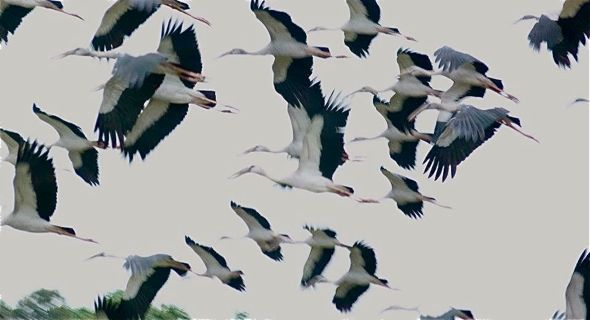Lena Chow journeyed north to Kampong Batang Tiga in the Malaysian state of Malacca on 19th January 2013 to take in the sight of the migrating Asian Openbills (Anastomus oscitans). Masses of them made spectacular aerial display as they arrived to forage in the paddy fields (above, below). Their favourite food item may be the many apple snails found between the stumps of the rice plants. Their pincer-shaped bill-tip enables them to cut open the operculum of the snail, shake it to loosen the body, leaving the shell intact (Wells, 1999). At the same time they also looked for small aquatic animals like frogs and crabs as well as large insects.
The Asian Openbill, like most storks, is not a true migrant. Juveniles from the central Thailand population have been reported to make erratic dispersal, with most moving westward to as far as Bangladesh and eastward to Cambodia.
The current migrating population that number as high as a thousand or more birds, most probably come from Thailand. After all, Thailand has the largest population of 8-14,000 nests (Elliott, 1992). However, movements southwards have not been recorded below latitude 13° N (Wells, 1999).
According to Lena: “There were also Imperial, Greater Spotted and Steppe Eagles. [The image below] shows part of a flock of 200+ openbills resting in the paddy field. I believe the whiter birds are those in breeding plumage. The majority are the usual dull greyish-white.”
This is the first time when masses of up to a thousand birds are flocking throughout Peninsular Malaysia. Birdwatchers got the news as early as 9th January 2013 when the birds were reported in Ipoh. A few of the birds have now reached the southernmost tip of the peninsular – HERE. This is also the first time the Asian Openbill has been reportedly seen in Singapore.
There can only be speculations as to what triggered this mass migration. Local movements tend to be connected to a depletion of food supplies (Elliott, 1992). So is it possible that this southward movement is a result of food depletion within their normal feeding range? A result of climate change perhaps?
Lena’s video clip shows the flocking birds somewhat darkening the sky over the paddy fields in Batang Tiga. Local birdwatchers were there in full force to witness this unusual spectacle.
Lena Chow
Singapore
January 2013
References:
1. Elliott, A., 1992. Family Ciconiidae (Storks). In: del Hoyo, J., A. Elliott & J. Sargatal (eds.), Handbook of the birds of the world. Vol. 1. Ostrich to Ducks. Lynx Editions, Barcelona. Pp. 436-465.
2. Wells, D.R., 1999. The birds of the Thai-Malay Peninsular. Vol. I, Non-passerines. Academic Press, London. 648 pp.













3 Responses
18 Jan 13 (6.10pm) – A group of a hundred was reported by a friend heading north-easterly over Butterworth.
19 Jan 13 (6.45pm) – I saw a group of 16 birds at the same location using the thermal heat circling and flying high above on northerly course.
24 Jan 13 (11.00am) – I believe the same 100 birds were heading toward Songkhla Lake (NE direction) from Kangar, Perlis (North Peninsular Malaysia).
The massive flood last year could possibly wipeout the apple snails.
Would be interesting to chart the route taken by them.
I doubt the first sighting is from Ipoh, had not heard of any sightings in Ipoh thus far, but the 1st impressive report is the 1000+ at Kuala Gula, Perak on 8th Jan but broadcasted on 9th Jan when they start to show up at Batang Tiga. Still looking for it in inland Perak but they seemed to be more towards the coastal paddyfields now, the most inland for Perak is probably at Chuichak which are likely individuals flying there from nearby Ulu Dedap where they also colonized for this season.